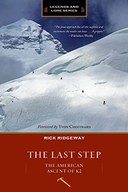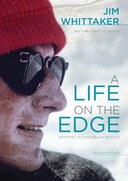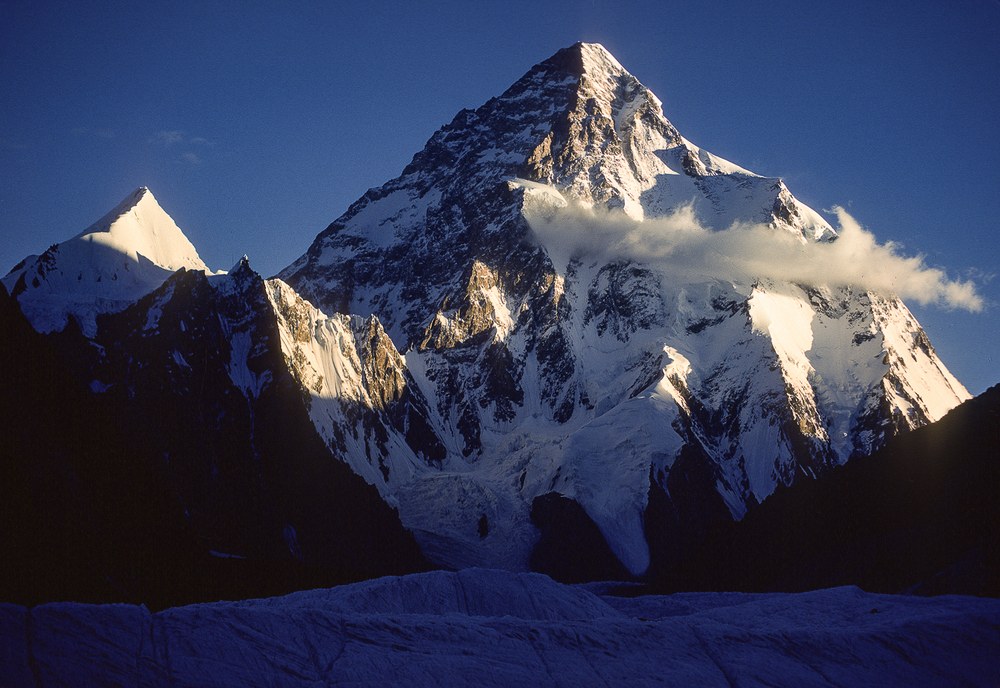
As a teenager in the 1950s, I was a voracious reader fascinated with several books that became the classic accounts of the so called “Golden Age” of Himalayan mountaineering. Among this treasure trove was K2: The Savage Mountain, the unforgettable story of the 1953 American K2 expedition. It stirred a fascination with K2 in me which has lasted a lifetime.
Around the same time, my interest was piqued by an old black-and-white photo of K2 in a history of Himalayan mountaineering. With its perfect, conelike shape, K2 called to me as Everest never did. In high school leafing through a history of Himalayan expeditions, I saw a photograph of the mountain, as steep and symmetrical as an Egyptian pyramid, and dreamed of one day climbing it. I am still struck by how this image foreshadowed the very route that Lou Reichardt, Terry Bech, and I took in September 1978 to the summit of K2, ploughing our way through deep snow from one side of the mountain to the other to establish Camp 6 at 25,800 feet. That traverse enabled us to link up with the Abruzzi route taken by the Italians in 1954 on the first ascent of the mountain.
Learning From Failure
When I recall my experiences on K2, I think not only about our successful 1978 expedition, but also our attempt in 1975 that ended abruptly at 22,000ft. We were on the still unclimbed complete Northwest Ridge, and reached the first of several jagged pinnacles that barred further progress. To see the entire 360-degree view from our high point, Leif Patterson, Lou Whittaker, and I were forced to straddle a narrow blade of icecovered rock, one at a time. It remains one of the most exposed spots I’ve found myself, sitting on that sawhorse with thousands of feet of air beneath the soles of my boots.
We learned a lot from that failure. To climb K2 requires not only a strong team but one joined together in achieving a common goal. Although we didn’t expect our expedition to be riddled with dissension and bickering, that’s what happened. If the unclimbable route had not stopped us, our inability to overcome our differences would have.
At the time I thought some of my teammates had made a mistake in going to K2 because they lacked motivation for the summit. I didn’t see it then, but I gradually came to realize that my singleminded drive to get to the top of K2 contributed to the discord. I promised myself that the next time I made a summit attempt, our expedition would be united.
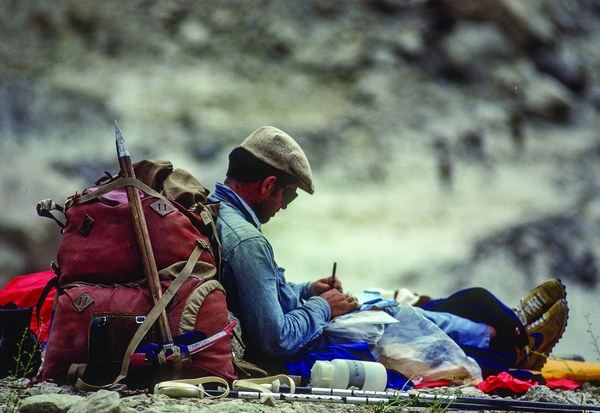 JIM WICKWIRE WRITES IN HIS DIARY, AT LILLIWA CAMP, DURING A REST ON THE APPROACH MARCH.
JIM WICKWIRE WRITES IN HIS DIARY, AT LILLIWA CAMP, DURING A REST ON THE APPROACH MARCH.
Carrying On In The Face Of Tragedy
We planned to return to K2 in three years, but Pakistan’s Ministry of Tourism issued the single permit for 1978 to Chris Bonington’s British expedition. Never one to give up, Jim Whittaker asked his friend Senator Ted Kennedy to intervene with Pakistan’s Prime Minister Zulfikar Ali Bhutto. In January 1977 we received the electrifying news that we had been granted an additional permit as a “special case” for the summer of 1978.
Only a few weeks before this complete reversal in our fortunes, expedition member Leif Patterson, and his 12-year-old son Tor (along with an 18-year-old friend), were tragically killed during a climb only a few miles from the family home in British Columbia. In the hours and days after I received the terrible news, I could not stop thinking about Leif: his decency, his boyish smile, his voice with its lilt and hint of skepticism. It was Leif who had done more than anyone else to try to keep our divided team together on K2 in 1975.
And it was after Leif whom, years later, Jim Whittaker and Dianne Roberts named their second son.
To prepare for the K2 expedition, I went to Alaska’s remote Fairweather Range in July 1977 with three companions, still reeling from the loss. Two members of the Fairweather team, Dusan Jagersky and Al Givler, had been added to 1978 K2 expedition. Our goal was to attempt a difficult, unclimbed, unnamed peak. We summited shortly before midnight as the sky turned pink. As we traversed the upper north face to a saddle that would enable us to descend to base camp, one member of the roped pair slipped. Dusan and Al fell 4,000 feet down the sheer face and were killed. I did not cry for Al and Dusan for over a year. In the hospital in late 1978, recuperating from lung surgery after my second K2 trip, I suddenly burst into spasms of sobbing, as my grief for Al and Dusan finally poured out.
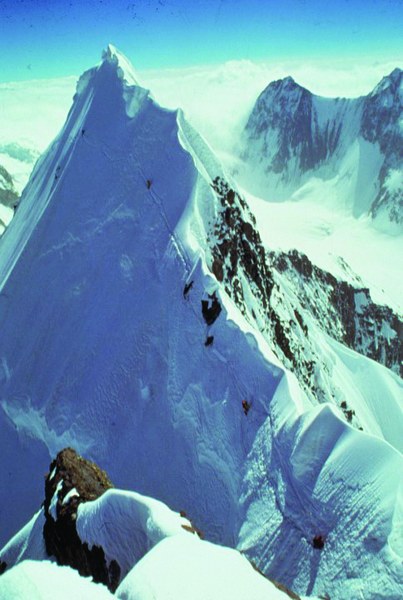 The corniced ridge and steep traverse between Camp III and Camp IV, with four climbers visible along the route. Photo taken from the top of the rock spire partly visible in the foreground, near Camp IV. Photo by John Roskelley
The corniced ridge and steep traverse between Camp III and Camp IV, with four climbers visible along the route. Photo taken from the top of the rock spire partly visible in the foreground, near Camp IV. Photo by John Roskelley
K2: Round Two
Our team of new and old faces went back to K2 in mid-June 1978. New additions included John Roskelley and Lou Reichardt, considered the country’s two strongest Himalayan climbers at the time. They joined me, Craig Anderson, Cherie Bech, Terry Bech, Chris Chandler, Diana Crist, Skip Edmonds, Rick Ridgeway, Dianne Roberts, Rob Schaller, Bill Sumner, and our expedition leader Jim Whittaker. Our fallen teammates Leif, Dusan, and Al went with us in spirit.
This time we were on the opposite side of the mountain. Our objective was the unclimbed Northeast Ridge – a route which, two years prior, defeated a tough-as-nails team from Poland on the summit pyramid, only 750 feet from the top.
We hoped we could avoid the disharmony of 1975, but we didn’t. We just had too many competing egos on our team. The story of how we ultimately succeeded in the face of these and other interpersonal difficulties has been told excellently in Rick Ridgeway’s The Last Step, published by Mountaineers Books in 1980. In short, we endured 67 days on the mountain – most of them above 18,000ft – many of which we spent pinned down by storms in tiny tents eating monotonous food and feeling building pressure to stand atop the Savage Mountain.
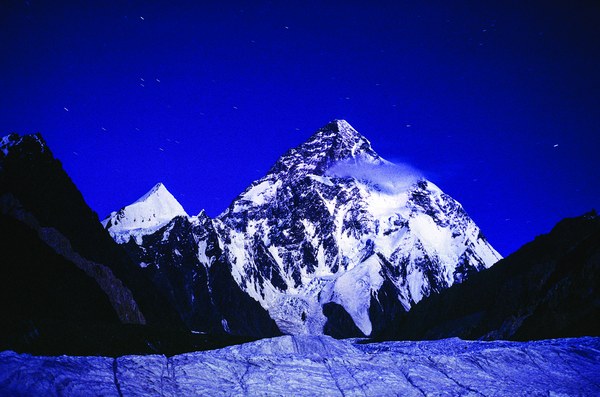 Our last view of K2, at night from Concordia camp, on the return march.
Our last view of K2, at night from Concordia camp, on the return march.
A successful summit, then a harrowing exit
When Lou Reichardt and I walked the last steps to the summit of K2, it was the culmination of a lifelong dream for me, and all of my teammates. Though we had planned to use minimal bottled oxygen, Lou’s set malfunctioned and he climbed without it. He wanted to head down immediately after reaching the summit, and we parted with the understanding that I would catch up with him at Camp 6. I had the team’s duty of burying a microfilm strip with the names of hundreds of contributors on the summit, and I also wanted to take panoramas of that stupendous view.
Night came quickly, and, rather than risk a fall in the dark, I decided to spend the night bivouacked not far below the summit on a small platform I scraped away in the snow. My oxygen soon ran out, and I faced 50 mph winds and temperatures of 35 below. I concentrated my mind on survival. I realized my violent shivers meant I was in the early stages of hypothermia. Though I could no longer feel my toes, I tried wiggling them anyway: tensing, relaxing, tensing, relaxing. “Move, move, move – keep the circulation going.” Somehow I made it through the night. No one had ever survived a solo bivouac above 27,000ft.
Beyond cold and hypoxic, the next morning I resumed my descent. At the top of a section called the Bottleneck, I encountered John Roskelley and Rick Ridgeway on their way up our route, having abandoned the Polish finish due to avalanche danger. I declined their offer of support, convinced I could descend to Camp 6 on my own. As my partner Lou Reichardt had done the day before, they climbed without oxygen, becoming the second pair to complete the first American ascent of K2. The complete Polish route John and Rick originally attempted remains unclimbed to this day.
Once we arrived down at Camp 1 (our advanced base camp), Rob Schaller, one of the team’s three doctors, diagnosed me with pneumonia, pleurisy, and pulmonary emboli. I had a clots in my lungs which would require immediately surgery. That agonizing first night Dianne Roberts and Diana Jagersky were my angels of mercy as they stayed close by my side. The retreat from the mountain became an ordeal. Through it all, Rob worked hard to keep me from succumbing to my ailments before I could be evacuated by helicopter to Skardu. This team saved my life.
On the last leg of the homeward journey, I wrote in my diary, “I should be on a terrible binge of euphoria now, but I am not. I have a cerebral satisfaction about the achievement. But gut-wise, deep in my emotional side, there is no spark. This I attribute to the bivouac at 27,700 feet, and to my illness. Both have drained me, and have cut sharply into the joy of standing on that high, isolated summit.”
 Rick Ridgeway at Base Camp after descending from the summit with frostbitten fingers. John Roskelley and Lou Reichardt suffered minor frostbite to the toes; John was evacuated by helicopter along with Jim Wickwire, who was gravely ill with pulmonary emboli. All four eventually recovered.
Rick Ridgeway at Base Camp after descending from the summit with frostbitten fingers. John Roskelley and Lou Reichardt suffered minor frostbite to the toes; John was evacuated by helicopter along with Jim Wickwire, who was gravely ill with pulmonary emboli. All four eventually recovered.
 K2 routes as seen from Windy Gap. Photo by Craig Anderson. Illustration by Ana Delucchi.
K2 routes as seen from Windy Gap. Photo by Craig Anderson. Illustration by Ana Delucchi.
A Climbing Community Response
I was happy to be reunited with my wife, Mary Lou, and our five young children, but it took some time for me to see the results of the 1978 trip in a more positive light. The response of several of the 1953 K2 climbers who had been my teenage heroes helped expel my funk. While I recovered at home, one of my first visitors was Pete Schoening who, on the 1953 trip, saved five falling teammates from certain death with his legendary ice ax belay.
When the accident occurred, Pete and his teammates were engaged in the almost impossible task of lowering a desperately sick Art Gilkey down the mountain from their camp at 25,000ft. Whenever asked about their actions high on K2, Art’s teammates would decline the hero’s mantle. For them, it had simply been about fulfilling the duty climbers have to one another in such circumstances. Expedition leader Charlie Houston later referred to this as “the brotherhood of the rope.”
In addition to Pete, fellow 1953 team members Bob Bates, Dee Molenaar, and Bob Craig called with their congratulations. Charlie Houston followed with a wonderful letter, the beginning of a close friendship between us. I felt honored when Bob later asked to write the foreword to Mountaineers Books reissue of K2: The Savage Mountain, advising me that “the main idea is to help tie together, in spirit, all of us who for 40 years have left America to try our best to climb K2.”
The K2 Bond: Looking Back On It All
Forty-years later, I cannot help but feel incredibly fortunate to be one of the members of the expedition to end the long quest for K2. The public spotlight is invariably on those who reach the summit, with insufficient attention devoted to the team accomplishment. The truth is we couldn’t have climbed K2 without Jim Whittaker’s strong and enthusiastic leadership and the dogged work of the entire team. Only together did we share in pioneering the route and carrying load after load.
When I’m asked about the significance of our climb in the larger context of mountaineering history, I think it will stand as one of the important early ascents of K2, marking the first non-Abruzzi route to be completed on the mountain, and the first oxygenless ascent. I am glad we were able to pull off an alpine-style finish from Camp 5 to the summit without the use of fixed ropes, now common on the summit pyramid. Remarkably, we shunned the use of climbing ropes going to the summit, save for one linking Lou Reichardt and me, which we discarded at 27,300ft to explore alternatives to the deep snow that greatly slowed our progress.
It took 20 years, but in 1998, at the behest of the Mazamas in Portland, we held a reunion of our 1978 expedition. We were missing Chris Chandler – who perished from cerebral edema at 25,000ft on Kanchenjunga during a winter attempt in 1985 – but nine team members were able to attend. What made our first gathering special was that the entire 1953 K2 expedition team joined us. Our heroes were much older men, but with the curious phenomenon of advancing years, the age gap between us felt somehow diminished.
Today, only Tony Streather and Dee Molenaar are left from the 1953 team. When Dee celebrated his 100th birthday in July 2018 at Mt. Rainier, several of us from the 1978 team were delighted to join him, his family, and other admirers to celebrate.
The proof of our own “brotherhood of the rope” was evident when the Bechs – Terry and Cherie – volunteered to carry loads for Lou Reichardt and me so we could complete the crucial traverse across the upper mountain. Cherie was forced to turn back, exhausted from the severe hypothermia she suffered in reaching Camp 5 at 25,000ft. I know from my own encounters with teammates over the years that we feel mutual pride and satisfaction about what we were able to accomplish together. Whether you personally reach the summit is not the most important; the team’s success is what truly counts.
A 40th Anniversary Celebration
In early September 2018, our 1978 team will gather once again to celebrate the 40th anniversary of this American summit of K2. Though we’ve also lost Rob Schaller, who sadly passed away in December 2014, I eagerly look forward to joining my other teammates to mark the exact anniversary of the first summit: September 6. We’re excited to be back on our home turf where it all started, and I know The Mountaineers’ celebration will be particularly meaningful. We are all connected through the power of community.
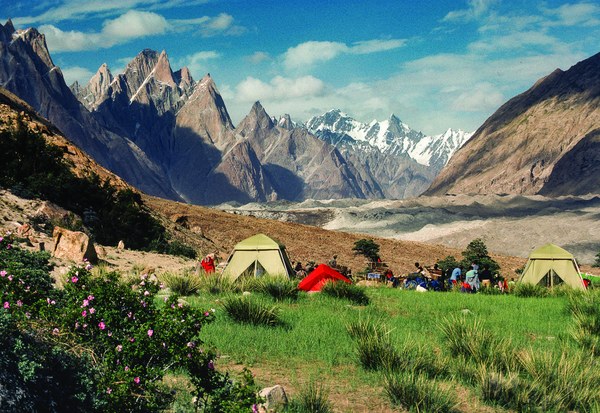 The last camp on the approach march before embarking on the 70+ mile trek along the icy, rocky length of the Baltoro Glacier. The soaring granite faces of the Trango Towers are in the background.
The last camp on the approach march before embarking on the 70+ mile trek along the icy, rocky length of the Baltoro Glacier. The soaring granite faces of the Trango Towers are in the background.
This article originally appeared in our Fall 2018 issue of Mountaineer Magazine. To view the original article in magazine form and read more stories from our publication, click here.
 Jim Wickwire
Jim Wickwire
